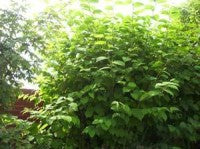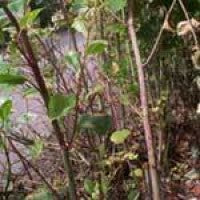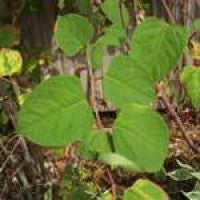Weed of the Week: Japanese knotweed Fallopia japonica
Weed of the Week: Japanese knotweed (Fallopia japonica)
By Laurence Gale

What is a weed? By definition a weed is a plant that is growing in the wrong place. Weeds take valuable space, water, sunlight and nutrients that may otherwise be accessible to important crops, in our case turf grasses. Weeds not only compete for these resources they can disfigure and cause problems to playing surfaces.
Weeds are very good competitors and take advantage of any opportunities to colonise turf situations, particularly when the sward is under stress and weak, leaving bare soil areas for weeds to populate. Weeds have many mechanisms and characteristics that enable them to do this, having thick waxy cuticle leaves that can be resistant to some chemicals, fast reproduction methods, the ability to reseed in 6 week cycles and deep tap roots enabling the weed to survive in compacted dry ground conditions.
Weeds have one of three life cycles: annual; biennial or perennial.
- Annual weeds: Live for a single season. These weeds germinate from seed in the spring or summer, flower and then die.
- Biennial weeds: Live for two seasons. During the first growing season, these weeds remain in a vegetative stage and, in the following year, produce flowers, set seed and die.
- Perennial weeds: Live for multiple seasons and flower more than once. Perennial structures (rhizomes, stolons, crowns, entire plants or roots) survive from year to year.
Some weeds may be harmful to the environment or noxious to your regional ecology. For example Japanese Knotweed (Fallopia Japonica) is fast becoming a major weed problem on road side verges and urban landscape areas, a very difficult weed to eradicate. It is very important to recognise weeds and seek effective controls methods to eradicate them from our facilities.
Weeds can also be used as an indicator of soil conditions. For example, knotweed and plantains both indicate soil compaction because they can maintain adequate root respiration at lower oxygen diffusion levels than other plants. Different weeds tolerate different soil conditions, some are alkaline loving and others acid loving. Getting to understand and recognise the physiology of these plants will help you become better turfgrass managers.
This week's weed is: Japanese knotweed Fallopia japonica
Fallopia japonica, commonly known as Japanese Knotweed, is also known by the scientific names Polygonum cuspidatum and Reynoutria japonica. This rhizomatous perennial invades habitats primarily through vegetative reproduction, though the plants are known to produce abundant displays of tiny white flowers followed by seed. There are many different approaches to controlling Knotweed, but they all fit into three basic categories; mechanical, chemical and biological - and any permutation of the three.
|
Scientific name
Family Life cycle |
Fallopia japonica,
Polygonum perennial |

|
| Form / Appearance | Japanese Knotweed is a prolific weed that grows in dense clumps up to 3m in height, on tubular stems that ascend from the base of the plant. The plant dies back each year, leaving the stems to form a protective framework over the newly forming emerging shoots that begin to grow in the following spring. |

|
| Roots | The roots are woody and have been recorded to depths of 1-5 m or more. The plant forms rhizomes 0.5-5cm in diameter that spread up to 7m laterally each year. The ability of this plant to reproduce itself by rhizomes is the reason this weed so invasive. | |
| Flowers | Knotweed forms panicles of white flowers up to 10cm long. The plant flowers from August to October before dying back to leave brittle hollow stems that stand throughout the winter. |

|
| Leaves | Leaves are 6-12 cm x 5-10 cm in size, broadly ovate and truncate at the base. |

|
| Reproductive method | This plant can reproduce itself by seed and by rhizomes. It's vigorous powers of vegetative reproduction mean that it has been able to spread to all parts of the British Isles without the aid of sexual reproduction. | |
| Habitat | This plant can tolerate most soil conditions, including very acidic soils. The plant is commonly found to populate railway and river embankments. Once introduced will grow in most situations. Establishment and competition with other plant species is aided by a number of characteristics. Firstly, it's ability to grow tall, out smothering many other plant species, it's ability to reproduce by rhizomes and, finally, the amount of debris it leaves behind each year which eventually forms a carpet that shades out other plant flora. This plant is also shade tolerant. |

|
| Miscellaneous info | Knotweed is a native plant of Japan, Taiwan and Northern China. It was first introduced to Europe and brought to the British Isles in 1825 as an ornamental plant that was collected by gardeners. However, these small collections often changed hands and, over time, the plant began to be spread. | |
| Cultural Control |
Once this weed gets established, it is often difficult to remove or eradicate. However, there are a number of tactics now being used to eradicate or reduce the spread of this weed. In most cases they are labour intensive:
A combination of cutting and herbicide is probably the most effective. Chemical control is expensive, not always 100% effective and can have a negative effect on the environment. Due to these problems there is now an increasing interest in the use of biological control, using natural pest and diseases to control the weed. For further information you can link into the Loughborough University web site. |
|
| Chemical Control |
Apply non-selective herbicides when plant growth is active. There are a number of products available for controlling Japanese Knotweed. These chemicals are best used when the weeds are actively growing, usually between April-October. Particular care should be taken when using chemicals near to water courses, rivers, streams and ponds.
These herbicides are usually applied as a liquid using watering cans, knapsack sprayers and vehicle mounted sprayers. Ensure you follow manufacturer's directions, health & safety and product data sheets, and comply with COSHH regulations, when using these chemicals. Herbicides are an effective tool where high quality turf is desired. However, they must be applied with care and accuracy and in the context of a good overall turf management program. Before using any herbicide, carefully review the label for conditions of use including rates, methods of application, and precautions. Never use a herbicide in any manner contrary to its label and be sure that the herbicide will not injure the turfgrass species |
Other sites for information on Weed control see the DEFRA @ www.defra.gov.uk/environ/weedsact/default.htm
Wildlife and Countryside ACT 1981:@ www.workingforwildlife.org.uk/conservation/wildlifeact.htm
